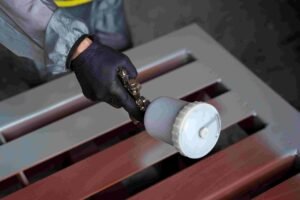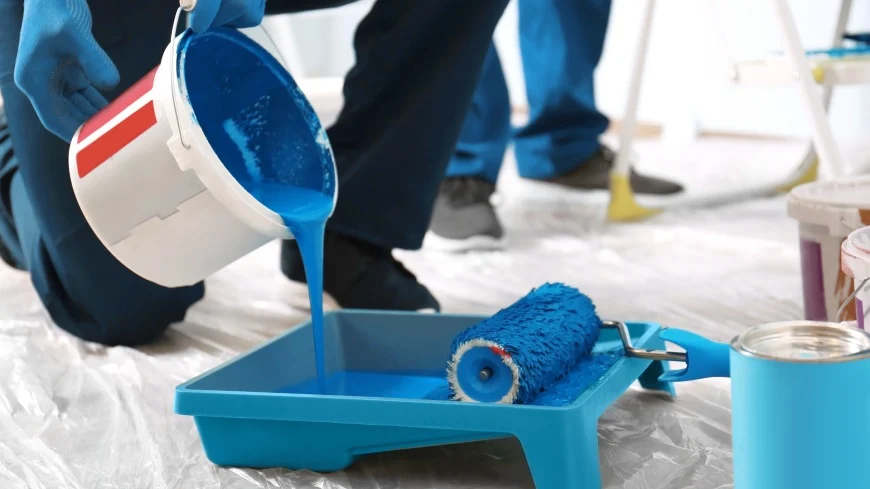An Introduction to Mithila Paints
Mithila Paints has established itself as a pioneering force in the paint and coatings industry. With a robust history that dates back several decades, the company has consistently demonstrated an unwavering commitment to quality and innovation. Founded on principles of excellence and customer satisfaction, Mithila Paints has evolved from a small-scale operation into a leading manufacturer renowned for its high-performance coatings.
The company’s mission revolves around delivering cutting-edge solutions that cater to diverse industrial and residential needs. By continually investing in advanced technologies and research, Mithila Paints has managed to stay ahead of industry trends and meet the ever-evolving demands of its clientele. Their dedication to innovation is particularly evident in their production of polyurethane coatings, which combine superior durability with aesthetic appeal.
Key achievements of Mithila Paints include the development of eco-friendly products that minimize environmental impact while delivering top-notch performance. The company’s R&D team has played a pivotal role in this regard, striving to create formulations that adhere to stringent regulatory standards and optimize application processes. Through a steadfast focus on sustainability, Mithila Paints has garnered several industry accolades, cementing its reputation as a responsible manufacturer.
As we delve deeper into the specifics of Mithila Paints’ manufacturing processes and product offerings, it becomes clear that their expertise in polyurethane coatings is a testament to their overarching strategy. This exploration will shed light on how the company harnesses advanced materials and state-of-the-art machinery to produce coatings that meet the highest standards of quality. Ultimately, Mithila Paints exemplifies how a blend of art and science can lead to groundbreaking advancements in the coating industry.
What Are Polyurethane Coatings?
Polyurethane coatings represent a significant advancement in material science, offering versatile solutions across various industries. These coatings are primarily formulated using polyols and isocyanates, which react to form a durable polymer. The resultant polyurethane coatings can be customized to fit a range of applications, exemplifying an advanced protective layer that enhances both the durability and aesthetic appeal of surfaces.
Polyurethane coatings are available in two primary forms: water-based and solvent-based. Water-based polyurethane coatings are prized for their low environmental impact, emitting fewer volatile organic compounds (VOCs). These coatings dry relatively quickly and provide a clear, non-yellowing finish, making them an excellent choice for indoor applications such as floors, furniture, and cabinetry. On the other hand, solvent-based polyurethane coatings tend to offer superior durability and resistance to chemical, abrasion, and temperature extremes. These properties make solvent-based formulations ideal for industrial and outdoor applications, including automotive finishes, marine coatings, and heavy machinery protection.
Key attributes of polyurethane coatings include their exceptional toughness and flexibility. They are highly resistant to water, chemicals, and mechanical wear and tear. This makes them a preferred material for surfaces that demand both robustness and aesthetic integrity. Moreover, polyurethane coatings can be formulated to be glossy or matte, colored or clear, catering to diverse industry requirements and stylistic preferences.
Due to these advantageous properties, polyurethane coatings are extensively used in sectors such as automotive, aerospace, manufacturing, and consumer goods. Their ability to provide long-lasting, high-performance finishes elevates their importance in any application that desires not only protection but also a visually appealing surface.
Understanding the formulation and benefits of polyurethane coatings elucidates why they hold a prominent place in modern manufacturing processes. Their dual functionality in enhancing durability and offering aesthetic flexibility underscores their indispensable role across a myriad of industries.

The Science Behind Polyurethane Coatings
Polyurethane coatings stand out in the realm of protective and decorative finishes due to their unique chemistry, which involves the polymerization of isocyanates and polyols. This chemical reaction forms a robust, versatile polymer matrix that boasts excellent durability and flexibility.
Isocyanates, typically aromatic or aliphatic, react with polyols to create urethane linkages. Aromatic isocyanates are known for their superior mechanical properties and affordability, whereas aliphatic isocyanates provide exceptional UV resistance. Polyols, on the other hand, can vary in molecular weight and functionality, influencing the coating’s hardness, elasticity, and chemical resistance. By carefully selecting these reactants, manufacturers can tailor the performance characteristics of polyurethane coatings to specific applications.
Additives play a crucial role in enhancing the functionality of polyurethane coatings. Stabilizers can improve shelf-life, pigments impart desired colors, and UV absorbers shield the coating from sun damage. Flow modifiers ensure an even application, while thickeners adjust the viscosity to suit different application techniques, such as spraying or brushing.
Polyurethane coatings undergo curing processes to achieve their final properties. Air-drying urethanes cure at ambient temperatures, which is convenient for a variety of environments but may result in longer drying times. Heat-curing, in contrast, involves baking the coating at elevated temperatures, accelerating the cross-linking reaction and providing superior mechanical and chemical resistance. The choice between these curing methods hinges on the specific requirements of the project, including desired performance characteristics and environmental constraints.
Understanding the intricate science of polyurethane coatings reveals why they are highly valued across diverse industries. From automotive finishes and industrial machinery to wood furniture and flooring, the chemistry and curing techniques employed in polyurethane coatings contribute significantly to their effectiveness and widespread applicability.


Raw Materials and Quality Control
The foundation of Mithila Paints’ polyurethane coatings lies in the meticulous selection and evaluation of raw materials. The primary ingredients include polyols, isocyanates, and various additives such as stabilizers, catalysts, and pigments. Each of these components is sourced from reputable suppliers who are renowned for their high standards in material purity and consistency. Mithila Paints prioritizes high-purity ingredients to ensure the performance and durability of their coatings, as even minimal impurities can significantly impact the final product’s quality.
Quality control is a critical aspect of the manufacturing process at Mithila Paints. Upon receipt, all raw materials undergo rigorous testing in state-of-the-art laboratories. These tests include assessments of chemical composition, viscosity, density, and moisture content, among other parameters. Such comprehensive testing ensures that each batch of material meets the strict quality specifications set by the company before it enters the production line.
The quality assurance processes at Mithila Paints encompass several stages to maintain consistency and reliability in their polyurethane coatings. During the production phase, in-process quality checks are conducted to monitor variables such as temperature, pressure, and time, which are crucial for the chemical reactions involved. Post-production, the final product undergoes extensive testing, including abrasion resistance, adhesion tests, and environmental exposure simulations, to verify compliance with industry standards and customer requirements.
Adherence to international standards, such as ISO and ASTM, is a hallmark of Mithila Paints’ commitment to quality. The company’s certifications and compliance with these standards underscore its dedication to delivering high-performance, durable polyurethane coatings. By integrating stringent quality control measures and leveraging high-purity raw materials, Mithila Paints ensures that their products not only meet but often exceed industry expectations.

The Manufacturing Process
The production of high-quality polyurethane coatings at Mithila Paints involves a meticulously structured process, ensuring excellence at every stage. The journey commences with the selection and precise mixing of raw materials. Key ingredients include polyol and isocyanate compounds, which react to form the polymer matrix. The quality of these raw materials is critical, as it directly influences the final product’s performance.
In the initial stage of ingredient mixing, specific ratios of polyol, catalysts, pigments, and other additives are blended under controlled conditions. This step sets the foundation for the consistency and viscosity of the resultant polyurethane. The mixed batch undergoes thorough testing to verify its compliance with predefined standards, ensuring optimal reactivity and stability.
Subsequent to the mixing stage, the batch preparation phase ensues. Here, the mixture is degassed to remove any entrapped air, thus preventing defects in the final coating. The degassed mixture is then transferred to storage tanks, where it remains until it is necessary for the next phase.
Following batch preparation, the application techniques come into play. Polyurethane coatings can be applied using various methods, including spraying, brushing, or rolling, depending on the intended use. Each application technique is chosen based on factors like surface type, environmental conditions, and desired finish, with the aim to achieve even coverage and durability.
The final phase involves quality checks. Every applied layer undergoes rigorous inspection for thickness uniformity, adhesion, and resistance properties. Advanced testing methods such as chromatographic analysis, spectrophotometry, and mechanical endurance tests are employed to validate the coating’s performance. Any deviations detected are addressed promptly to maintain the high standards synonymous with Mithila Paints.
Throughout the polyurethane coating production, the implementation of meticulous process controls and real-time monitoring plays a crucial role in ensuring consistent product quality. For enhanced clarity and understanding of this sophisticated manufacturing procedure, incorporating visual aids such as flow charts or diagrams is recommended. These aids can illustrate the sequential steps and interdependencies within the process, providing a more comprehensive visualization for the readers.

Innovations and Technological Advancements
Mithila Paints has established itself as a pioneer in the polyurethane coatings industry through consistent investment in innovations and technological advancements. One of the most significant improvements is the integration of automation in their production process. Automation not only enhances production efficiency but also ensures consistent quality, reducing human errors and delivering superior products to customers.
To address the growing environmental concerns, Mithila Paints has developed eco-friendly formulations. These formulations minimize volatile organic compounds (VOCs), making the coatings less harmful to both the environment and human health. This move aligns with global trends towards sustainability and signifies Mithila Paints’ commitment to producing coatings that are not only high-performing but also responsible in terms of environmental impact.
A standout feature in Mithila Paints’ technological arsenal is the use of nanotechnology. By incorporating nanoparticles into their polyurethane coatings, the company has enhanced the performance characteristics of its products. These nano-scale particles improve the durability, scratch resistance, and chemical stability of the coatings, providing an edge over traditional formulations. This advanced technology ensures that Mithila Paints’ products meet the high demands of various industrial applications, further cementing their position as a leader in the field.
Through these innovations—automation, eco-friendly formulations, and nanotechnology—Mithila Paints exemplifies leadership and forward-thinking within the polyurethane coatings industry. The company’s dedication to incorporating cutting-edge technology not only propels their product quality to new heights but also sets a benchmark for competitors. As they continue to innovate, Mithila Paints aims to meet and exceed industry standards, ensuring that they remain at the forefront of technological advancements in polyurethane coatings.

Applications and Case Studies
Mithila Paints’ polyurethane coatings are renowned for their versatility and enduring performance across a spectrum of industries. Their application spans from the resilient finishes required in the automotive and aerospace sectors to the protective coatings indispensable in construction and consumer goods.
In the automotive industry, Mithila Paints’ polyurethane coatings are the epitome of durability and aesthetic appeal. A prime example is their collaboration with a leading car manufacturer to enhance the exterior robustness and gloss of high-end vehicles. The project resulted in improved scratch resistance and UV stability, significantly extending the lifecycle of the car finishes. Customer testimonials frequently highlight the coatings’ ability to maintain a showroom-like shine even under harsh environmental conditions.
The aerospace sector demands coatings that can withstand extreme temperatures and atmospheric pressures. Mithila Paints have developed specialized polyurethane coatings that are applied to aircraft fuselage and wings. A significant case study involved a major aerospace firm adopting these coatings, leading to reduced maintenance costs and enhanced safety margins due to increased material resilience. The client reported a 20% decrease in repainting needs and a notable improvement in operational efficiency.
Construction applications of Mithila Paints’ polyurethane coatings showcase their protective and aesthetic capabilities. From high-rise buildings to bridges, these coatings offer excellent resistance to corrosion, abrasion, and chemical exposure. An illustrative project includes the coating of a coastal infrastructure, where the materials faced constant attack from salty sea air. The application of polyurethane coatings led to heightened structural integrity and considerably lowered upkeep costs over a five-year period, as per the project reports.
In the realm of consumer goods, Mithila Paints’ coatings are used extensively on electronics, furniture, and sports equipment. A notable example is their involvement with a leading global furniture retailer, where the coatings were employed to enhance the aesthetic and functional lifespan of various products. customer feedback indicates a high satisfaction rate due to the coatings’ scratch resistance and vibrant color retention, leading to a boost in product desirability and sales figures.

Future Trends and Challenges
As the polyurethane coatings industry evolves, several trends and challenges are becoming increasingly prominent. Sustainability is at the forefront of discussions, driven by growing environmental awareness and stringent regulatory changes. Companies like Mithila Paints are striving to develop eco-friendly formulations that reduce volatile organic compounds (VOCs) and utilize renewable materials. These sustainable innovations not only meet regulatory standards but also cater to the rising consumer demand for green products.
Another significant trend is the advancing technology in smart coatings. Polyurethane coatings are increasingly being engineered to possess self-healing, anti-microbial, and anti-corrosive properties. These functionalities extend the lifespan of the coatings and offer additional benefits to end-users. Mithila Paints is investing in research and development to incorporate such advanced characteristics into their product line, thereby fortifying their market position as a leader in innovation.
The emerging market demands are another area of focus. With industries such as automotive, aerospace, and electronics continuing to grow, there is a persistent need for high-performance coatings that offer enhanced durability and efficiency. Mithila Paints is addressing this demand through continuous product enhancement and by adapting their manufacturing processes to ensure superior quality and performance of their polyurethane coatings.
The challenges facing the polyurethane coatings industry are not just limited to sustainability and market demands but also include adapting to rapid regulatory changes. As governments globally become more stringent with environmental laws, companies must pivot quickly to comply with new standards. Mithila Paints is proactively engaging with regulatory bodies and industry groups to stay ahead of these changes and ensure compliance without compromising on quality.
By staying at the cutting edge of innovation, adopting sustainable practices, and meeting the evolving needs of their markets, Mithila Paints is well-positioned to navigate the future trends and challenges in the polyurethane coatings industry. Their commitment to quality, research, and adaptability marks a promising outlook for continued success.
